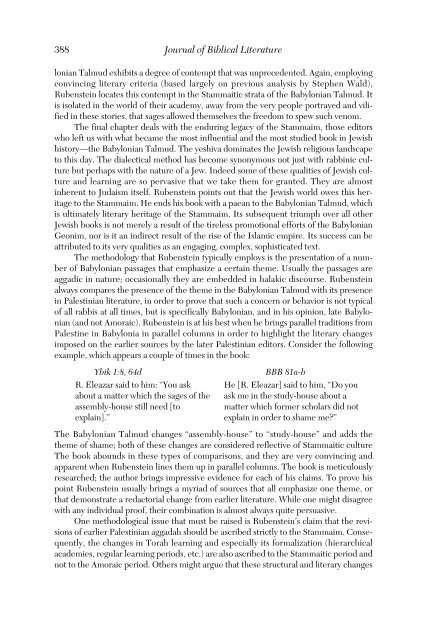Journal of Biblical Literature - Society of Biblical Literature
Journal of Biblical Literature - Society of Biblical Literature
Journal of Biblical Literature - Society of Biblical Literature
You also want an ePaper? Increase the reach of your titles
YUMPU automatically turns print PDFs into web optimized ePapers that Google loves.
388 <strong>Journal</strong> <strong>of</strong> <strong>Biblical</strong> <strong>Literature</strong><br />
lonian Talmud exhibits a degree <strong>of</strong> contempt that was unprecedented. Again, employing<br />
convincing literary criteria (based largely on previous analysis by Stephen Wald),<br />
Rubenstein locates this contempt in the Stammaitic strata <strong>of</strong> the Babylonian Talmud. It<br />
is isolated in the world <strong>of</strong> their academy, away from the very people portrayed and vilified<br />
in these stories, that sages allowed themselves the freedom to spew such venom.<br />
The final chapter deals with the enduring legacy <strong>of</strong> the Stammaim, those editors<br />
who left us with what became the most influential and the most studied book in Jewish<br />
history—the Babylonian Talmud. The yeshiva dominates the Jewish religious landscape<br />
to this day. The dialectical method has become synonymous not just with rabbinic culture<br />
but perhaps with the nature <strong>of</strong> a Jew. Indeed some <strong>of</strong> these qualities <strong>of</strong> Jewish culture<br />
and learning are so pervasive that we take them for granted. They are almost<br />
inherent to Judaism itself. Rubenstein points out that the Jewish world owes this heritage<br />
to the Stammaim. He ends his book with a paean to the Babylonian Talmud, which<br />
is ultimately literary heritage <strong>of</strong> the Stammaim. Its subsequent triumph over all other<br />
Jewish books is not merely a result <strong>of</strong> the tireless promotional efforts <strong>of</strong> the Babylonian<br />
Geonim, nor is it an indirect result <strong>of</strong> the rise <strong>of</strong> the Islamic empire. Its success can be<br />
attributed to its very qualities as an engaging, complex, sophisticated text.<br />
The methodology that Rubenstein typically employs is the presentation <strong>of</strong> a number<br />
<strong>of</strong> Babylonian passages that emphasize a certain theme. Usually the passages are<br />
aggadic in nature; occasionally they are embedded in halakic discourse. Rubenstein<br />
always compares the presence <strong>of</strong> the theme in the Babylonian Talmud with its presence<br />
in Palestinian literature, in order to prove that such a concern or behavior is not typical<br />
<strong>of</strong> all rabbis at all times, but is specifically Babylonian, and in his opinion, late Babylonian<br />
(and not Amoraic). Rubenstein is at his best when he brings parallel traditions from<br />
Palestine in Babylonia in parallel columns in order to highlight the literary changes<br />
imposed on the earlier sources by the later Palestinian editors. Consider the following<br />
example, which appears a couple <strong>of</strong> times in the book:<br />
Ybik 1:8, 64d BBB 81a-b<br />
R. Eleazar said to him: “You ask He [R. Eleazar] said to him, “Do you<br />
about a matter which the sages <strong>of</strong> the ask me in the study-house about a<br />
assembly-house still need [to matter which former scholars did not<br />
explain].” explain in order to shame me?”<br />
The Babylonian Talmud changes “assembly-house” to “study-house” and adds the<br />
theme <strong>of</strong> shame; both <strong>of</strong> these changes are considered reflective <strong>of</strong> Stammaitic culture<br />
The book abounds in these types <strong>of</strong> comparisons, and they are very convincing and<br />
apparent when Rubenstein lines them up in parallel columns. The book is meticulously<br />
researched; the author brings impressive evidence for each <strong>of</strong> his claims. To prove his<br />
point Rubenstein usually brings a myriad <strong>of</strong> sources that all emphasize one theme, or<br />
that demonstrate a redactorial change from earlier literature. While one might disagree<br />
with any individual pro<strong>of</strong>, their combination is almost always quite persuasive.<br />
One methodological issue that must be raised is Rubenstein’s claim that the revisions<br />
<strong>of</strong> earlier Palestinian aggadah should be ascribed strictly to the Stammaim. Consequently,<br />
the changes in Torah learning and especially its formalization (hierarchical<br />
academies, regular learning periods, etc.) are also ascribed to the Stammaitic period and<br />
not to the Amoraic period. Others might argue that these structural and literary changes

















